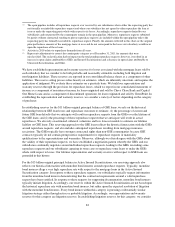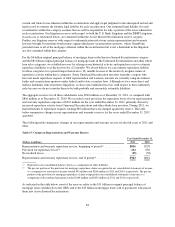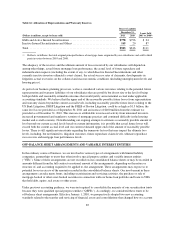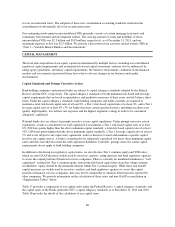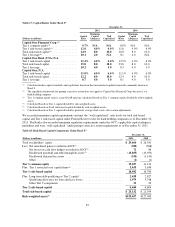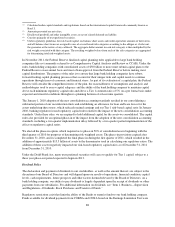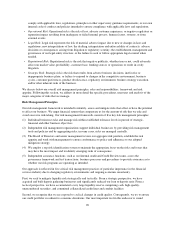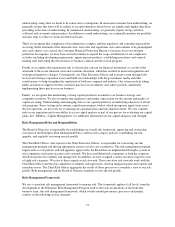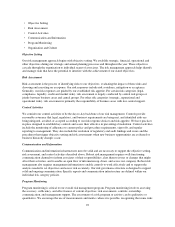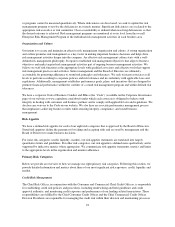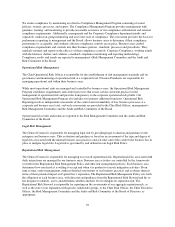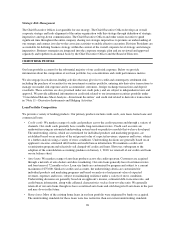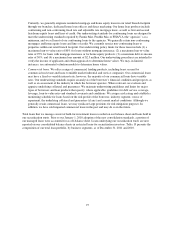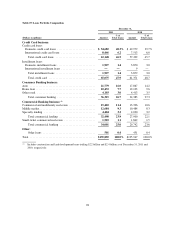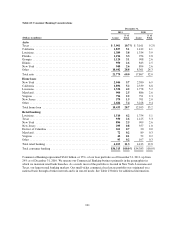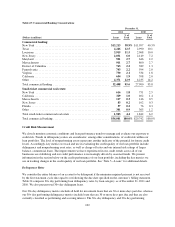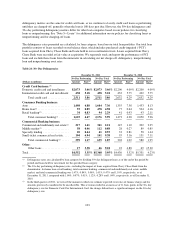Capital One 2011 Annual Report Download - page 113
Download and view the complete annual report
Please find page 113 of the 2011 Capital One annual report below. You can navigate through the pages in the report by either clicking on the pages listed below, or by using the keyword search tool below to find specific information within the annual report.or programs cannot be measured quantitatively. Where deficiencies are discovered, we seek to update the risk
management program to resolve the deficiencies in a timely manner. Significant deficiencies are escalated to the
appropriate risk executive or risk committee. Clear accountability is defined when resolving deficiencies so that
the desired outcome is achieved. Risk management programs are monitored at every level from the overall
Enterprise Risk Management Program to the individual risk management activities in each business area.
Organization and Culture
Our intent is to create and maintain an effective risk management organization and culture. A strong organization
and culture promotes risk management as a key factor in making important business decisions and helps drive
risk management activities deeper into the company. An effective risk management culture starts with a well-
defined risk management philosophy. It requires established risk management objectives that align to business
objectives and make targeted risk management activities part of ongoing business management activities. We
believe we staff risk functions at the appropriate levels with qualified associates and effective tools that support
risk management practices and activities. Senior management and the Board of Directors are ultimately
accountable for promoting adherence to sound risk principles and tolerances. We seek to incent associates at all
levels to perform according to corporate policies and risk tolerance and in conformity with applicable laws and
regulations. Additionally, management establishes performance goals, plans, and incentives that are designed to
promote financial performance within the confines of a sound risk management program and within defined risk
tolerances.
We have a corporate Code of Business Conduct and Ethics (the “Code”) (available on the Corporate Governance
page of our website at www.capitalone.com/about) under which each associate is obligated to behave with
integrity in dealing with customers and business partners and to comply with applicable laws and regulations. We
disclose any waivers to the Code on our website. We also have an associate performance management process
that emphasizes achieving business results while ensuring integrity, compliance, and sound business
management.
Risk Appetite
We have a defined risk appetite for each of our eight risk categories that is approved by the Board of Directors.
Stated risk appetites define the parameters for taking and accepting risks and are used by management and the
Board of Directors to make business decisions.
For some risk categories (credit, liquidity, market), our risk appetite statements are translated into largely
quantitative limits and guidelines. For other risk categories, our risk appetite is defined more qualitatively and is
supported by indicative metrics where appropriate. We communicate risk appetite statements, metrics and limits
to the appropriate levels in the organization and monitor adherence.
Primary Risk Categories
Below we provide an overview of how we manage our eight primary risk categories. Following this section, we
provide detailed information and metrics about three of our most significant risk exposures: credit, liquidity and
market.
Credit Risk Management
The Chief Risk Officer, in conjunction with the Consumer and Commercial Chief Credit Officers, is responsible
for establishing credit risk policies and procedures, including underwriting and hold guidelines and credit
approval authority, and monitoring credit exposure and performance of our lending-related transactions. These
responsibilities are fulfilled by the Chief Consumer Credit Officer and the Chief Commercial Credit Officer.
Division Presidents are responsible for managing the credit risk within their division and maintaining processes
93


